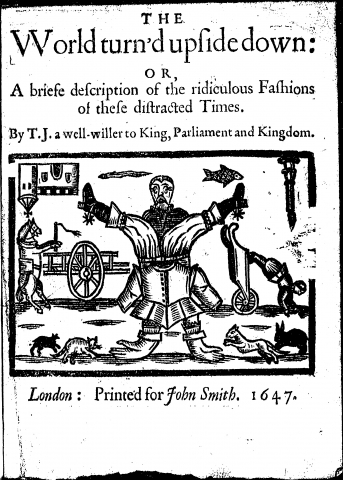
“The World Upside Down: Topsy-Turvy” was the theme for our first two-year cycle, 2013-15. It covers a range of ideas and meanings across time and place, all relating to the various ways expected order and hierarchy are challenged, changed, deliberately reversed, undermined, or ignored. Turning things upside down provides a change of perspective that allows us to see things in different ways. It suggests that change is directional even if sometimes it just appears as chaos. By engaging both power and play, the topsy-turvy challenges us to make connections across a wide range of humanities disciplines and concepts:
• Ritual: Rituals of inversion, which are common across cultures, and their political and social implications.
• Carnival: The festive play of carnival is all about making the world topsy-turvy, but carnival can also be the start of resistance to the usual order.
• Dynamics of Power: Revolutions turn things upside down, but so do smaller social and political changes. Changes in gender, class, and race relations have all been seen as upside-down by some, as have the shifts in generational power that result from migration.
• Genre: Artists may challenge generic expectations for particular purposes.
• Humor: Something is funny because some expected order is disrupted.
• Politics: While structural anthropologists and critics alerted us to the symbolic power of the world upside down, or inversion, less attention has been paid to the political dimensions, which can be both radical and conservative.
• Physical bodies: In yoga, inversions are important parts of every practice, and are believed to invigorate and clear the mind. What are the consequences of being physically upside down? How does that change the way you see the world?
As we explore upside down worlds, we are open to a range of questions: What constitutes the upside down in particular contexts? What is it like to live in an upside down world? What kinds of meanings has the upside down world carried? How has it been represented? How is it gendered? How does it shape or reflect ideas of race and ethnicity? How does it reflect anxieties and conflicts over social organization and political power? How have ideas of the world upside down been part of prophetic and apocalyptic movements? How have representations of the world upside down varied over time and place? How have social rituals used an upside down world for purposes of social critique? How have writers and artists employed the topsy-turvy–-through the disruption of generic rules or through rhetoric, themes, characters, and plot? We look forward to a wide-ranging, extended discussion of these questions over the next two years.
Image (call #31481) used with permission, courtesy of the Huntington Library, San Marino, California.



